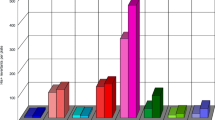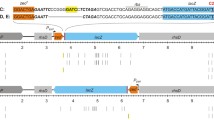Summary
We have previously reported some effects of DNA repair on the transition frequencies produced by an O6-methyl-guanine (MeG) or an O6-n-butyl-guanine (BuG) paired with C at the first position of the third codon in gene G of bacteriophage ΦX174 form I'DNA (Chambers et al. 1985). We now report experiments in which the transition is produced from T:MeG or T:BuG, instead of C:MeG or C:BuG, located at this site. The site-modified DNAs were transfected into cells with normal DNA repair as well as into cells with repair defects (uvrA, uvrB, uvrC, recA, uvrArecA). The lysates were screened for phage carrying the expected transition using a characteristic change in phenotype. The data demonstrate that the transition frequency from T:BuG is low (0.3% of total phage progeny) in cells with normal repair (Escherichia coli AB1157) and increases 7-fold in uvrA cells (E. coli AB1886). A similar increase is seen in uvrB and uvrC cells (AB1885, AB1884). These data, like our previous data, indicate BuG is repaired primarily by excision. In contranst to this, the transition frequency from T:MeG is high (5±2%) in cells with normal repair. After induction of alkyl transfer repair in E. coli AB1157, the transition frequency goes up 5-fold. Compared with cells with normal repair, the transition frequency goes up 2-fold in uvrA, uvrB and uvrC cells; it goes up 1.5-fold in recA cells (E. coli AB2463). The data reinforce our earlier conclusion that MeG is repaired primarily by alkyl transfer, but the ABC excinuclease as well as RecA protein inhibit this repair process. Using the BuG data reported here and in our previous paper, we calculate that BuG pairs with a thymine residue 0.5%–0.62% of the time during replication in vivo, and that BuG markedly inhibits replication of the strand that contains it. Because of the complication introduced by alkyl transfer repair, similar calculations for MeG cannot be made from the current data.
Similar content being viewed by others
Abbreviations
- MeG and BuG:
-
O6-methyl-or O6-n-butyl-guanine moiety in ΦX DNA (in each case, the plus strand nucleotide is specified first)
- form I'DNA:
-
relaxed, covalently closed, circular, double-stranded DNA
- Wt:
-
wild-type phenotype
- Am:
-
“amber” phenotype
- pfu:
-
plaque forming units
- MNNG:
-
N-methyl-N'-nitro-N-nitrosoguanidine
References
Bachmann BJ (1972) Pedigrees of some mutant strains of Escherichia coli K-12. Bacteriol Rev 36:525–557
Backendorf C, Spaink H, Barbeiro AP, van de Putte P (1986) Structure of the uvrB gene of Escherichia coli. Homology with other DNA repair enzymes and characterization of the uvrB5 mutation. Nucleic Acids Res 14:2877–2890
Bhanot OS, Ray A (1986) The in vivo mutagenic frequency and specificity of O6-methylguanine in ΦX174 replicative form DNA. Proc Natl Acad Sci USA 83:7348–7352
Bhanot OS, Khan SA, Chambers RW (1979) A new system for studying molecular mechanisms of mutation by carcinogens. J Biol Chem 254:12684–12693
Chambers RW, Sledziewska-Gojska E, Hirani-Hojatti S, Borowy-Borowski H (1985) UvrA and recA mutations inhibit a sitespecific transition produced by a single O6-methylguanine in gene G of bacteriophage ΦX174. Proc Natl Acad Sci USA 82:7173–7177
Drake JW (1970) The molecular basis of mutation. Holden-Day, San Francisco London Cambridge Amsterdam, pp 100–115
Eadie JS, Conrad M, Toorchen D, Topal MD (1984) Mechanism of mutagenesis by O6-methylguanine. Nature 308:201–203
Foote RS, Mitra S, Pal BC (1980) Demethylation of O6-methylguanine in a synthetic DNA polymer by an inducible activity in Escherichia coli. Biochem Biophys Res Commun 97:654–659
Friedberg EC (1985) DNA repair. Freeman, New York, pp 110–120
Gaffney BL, Marky LA, Jones RA (1984) Synthesis and characterization of a set of four dodecadeoxyribonucleoside undecaphosphates containing O6-methylguanine opposite adenine, cytosine, guanine, and thymine. Biochemistry 23:5686–5691
Guthrie GD, Sinsheimer RL (1963) Observations on the infection of bacterial protoplasts with the deoxyribonucleic acid of bacteriophage ΦX174. Biochim Biophys Acta 72:290–297
Howard-Flanders P, Boyce RP, Theriot L (1966) Three loci in Escherichia coli K-12 that control the excision of pyrimidine dimers and certain other mutagen products from DNA. Genetics 53:1119–1136
Howard-Flanders P, Theriot L, Stedford JB (1969) Some properties of excision-defective recombination-deficient mutants of Escherichia coli K-12. J Bacteriol 97:1134–1141
Kacinski BM, Rupp WD (1981) E. coli uvrB protein binds to DNA in presence of uvrA protein. Nature 294:480–481
Karran P, Lindahl T, Griffin B (1979) Adaptive response to alkylating agents involves alteration in situ of O6-methylguanine residues in DNA. Nature 280:76–77
Kornberg A (1980) DNA replication. Freeman, San Francisco, pp 396–402
Kuzmich S, Marky LA, Jones RA (1983) Specifically alkylated DNA fragments. Synthesis and physical characterization of d[CGC(O6 Me)GCG] and d[CGT(O6 Me)GCG]. Nucleic Acids Res 11:3393–3404
Lee AS, Sinsheimer RL (1974) Location of 5-methylcystosine group on the bacteriophage ΦX174 genome. J Virol 14:872–877
Lindahl T (1982) DNA repair enzymes. Annu Rev Biochem 51:61–87
Little JW, Mount DW (1982) The SOS regulatory system of Escherichia coli. Cell 29:11–22
Loechler EL, Green CL, Essigmann JM (1984) In vitro mutagenesis by O6-methylguanine built into a unique site in a viral genome. Proc Natl Acad Sci USA 81:6271–6275
Morimoto K, Dolan ME, Scicchitano D, Pegg AE (1985) Repair of O6-propylguanine and O6 butylguanine in DNA by O6-alkylguanine-DNA alkyltransferases from rat liver and E. coli. Carcinogenesis 6:1027–1031
Oh EY, Grossman L (1986) The effect of Escherichia coli Uvr protein binding on the topology of supercoiled DNA. Nucleic Acids Res 14:8557–8571
Olsson M, Lindahl T (1980) Repair of alkylated DNA in Escherichia coli. J Biol Chem 255:10569–10571
Patel DJ, Shapiro L, Kozlowski SA, Gaffney BL, Jones RA (1986a) Structural studies of the O6-meG:C interaction in the d(C-G-C-G-A-A-T-T-C-O6meG-C-G) duplex. Biochemistry 25:1027–1036
Patel DJ, Shapiro L, Kozlowski SA, Gaffney BL, Jones RA (1986b) Structural studies of the O6-meG:T interaction in the d(C-G-T-G-A-A-T-T-C-O6meG-C-G) duplex. Biochemistry 25:1036–1042
Pearlman DA, Holbrook SR, Pirkle DH, Kim SH (1985) Molecular models for DNA damaged by photoreaction. Science 227:1304–1308
Radman M, Wagner R, Glickman BW, Meselson M (1983) Methylation, mismatch correction, and genetic stability. In: Alacevic M (ed) Progress in environmental mutagenesis. Elsevier/North Holland Biomedical Press, Amsterdam, pp 121–130
Robins P, Cairns J (1979) Quantitation of the adaptive response to alkylating agents. Nature 280:74–76
Rupp WD, Sancar A, Sancar GB (1982) Properties and regulation of the UvrABC endonuclease. Biochimie 64:595–598
Sancar A, Rupp WD (1983) A novel repair enzyme: UvrABC excision nuclease of Escherichia coli cuts a DNA strand on both sides of the damaged region. Cell 33:249–260
Sancar A, Franklin KA, Sancar GB (1984) Escherichia coli DNA photolyase stimulates uvrABC nuclease in vitro. Proc Natl Acad Sci USA 81:7397–7401
Sancar A, Franklin KA, Sancar G, & Sancar A (1985) Repair of psoralen and acetylaminofluorene DNA adducts by ABC excinuclease. J Mol Biol 184:725–734
Seeberg E (1978) Reconstruction of an Escherichia coli repair endonuclease activity from their separated uvrA + and uvrB +/uvrC + gene products. Proc Natl Acad Sci USA 75:2569–2573
Seeberg E (1981) Multiprotein interactions in strand cleavage of DNA damaged by UV and chemicals. Prog Nucleic Acids Res Mol Biol 26:217–226
Todd ML, Schendel PF (1983) Repair and mutagenesis in Escherichia coli K-12 after exposure to various alkyl-nitrosuguanidines. J Bacteriol 156:6–12
Toorchen D, Topal MD (1983) Mechanisms of chemical mutagenesis and carcinogenesis; effects on DNA replication of methylation at the O6-guanine position of dGTP. Carcinogenesis 4:1591–1597
Topal M, Baker MS (1982) DNA precursor pool: A significant target for N-methyl-N-nitrosourea in C3H/3T1/2 clone 8 cells. Proc Natl Acad Sci USA 79:2211–2215
Van Houten B, Sancar A (1987) Repair of N-methyl-N'-nitro-N-nitrosoguanidine-induced DNA damage by ABC excinuclease J Bacteriol 169:540–545
Van Houten B, Gamper H, Holbrook SR, Hearst JE, Sancar A (1986) Action mechanism of ABC excision nuclease on a DNA substrate containing a psoralen crosslink at a defined position. Proc Natl Acad Sci USA 83:8077–8081
Walker GC (1985) Inducible DNA repair systems. Annu Rev Biochem 54:425–457
Witkin EM (1976) Ultraviolet mutagenesis and inducible DNA repair in Escherichia coli. Bacterial Rev 40:869–907
Author information
Authors and Affiliations
Additional information
Communicated by B.J. Kilbey
ΦX mutants are named by designating the gene, the type of mutation (e.g. ms=missense), the codon number, the mutant codon and the new amino acid (where pertinent) in that order (e.g. ΦXGam3) carries an amber in the third codon of gene G, and should not be confused with the classical am3 mutant used in the older literature to designate what is now known to be ΦXEam7
Rights and permissions
About this article
Cite this article
Chambers, R.W., Sledziewska-Gojska, E. & Hirani-Hojatti, S. In vivo effect of DNA repair on the transition frequency produced from a single O6-methyl-or O6-n-butyl-guanine in a T:G base pair. Mol Gen Genet 213, 325–331 (1988). https://doi.org/10.1007/BF00339598
Received:
Issue Date:
DOI: https://doi.org/10.1007/BF00339598




